Qantas Case Study Analysis
VerifiedAdded on 2020/03/13
|8
|2515
|73
AI Summary
This assignment requires a comprehensive analysis of Qantas Airways, examining its strategies, challenges, and overall performance based on the provided annual reports, news articles, and data. Students need to evaluate Qantas' financial health, operational efficiency, customer satisfaction, and competitive landscape. The analysis should draw insights from the given resources and demonstrate critical thinking about the airline industry.
Contribute Materials
Your contribution can guide someone’s learning journey. Share your
documents today.

Running Head: ANCILLARY REVENUES IN QANTAS AIRLINES 1
Ancillary Revenues in Qantas Airlines
Ancillary Revenues in Qantas Airlines
Secure Best Marks with AI Grader
Need help grading? Try our AI Grader for instant feedback on your assignments.
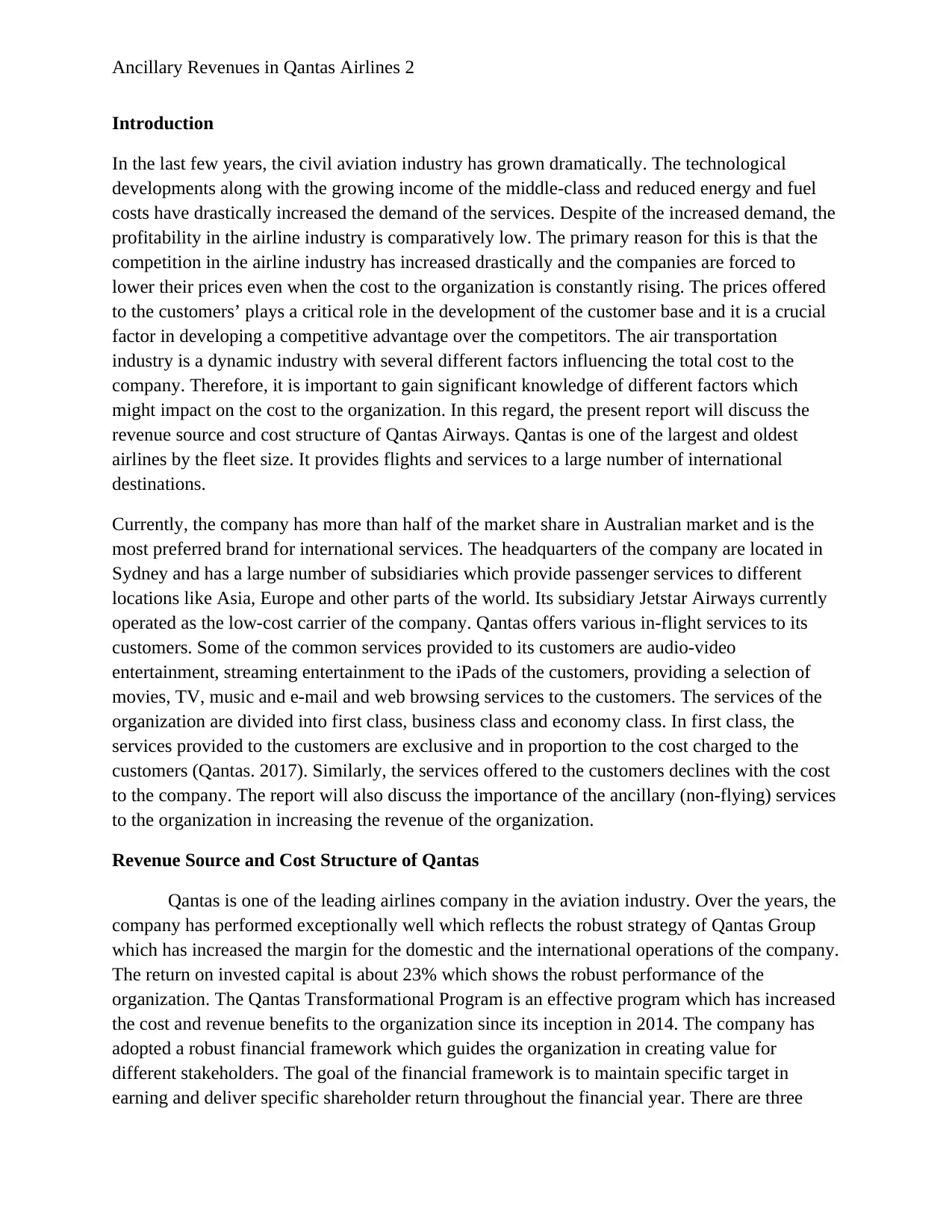
Ancillary Revenues in Qantas Airlines 2
Introduction
In the last few years, the civil aviation industry has grown dramatically. The technological
developments along with the growing income of the middle-class and reduced energy and fuel
costs have drastically increased the demand of the services. Despite of the increased demand, the
profitability in the airline industry is comparatively low. The primary reason for this is that the
competition in the airline industry has increased drastically and the companies are forced to
lower their prices even when the cost to the organization is constantly rising. The prices offered
to the customers’ plays a critical role in the development of the customer base and it is a crucial
factor in developing a competitive advantage over the competitors. The air transportation
industry is a dynamic industry with several different factors influencing the total cost to the
company. Therefore, it is important to gain significant knowledge of different factors which
might impact on the cost to the organization. In this regard, the present report will discuss the
revenue source and cost structure of Qantas Airways. Qantas is one of the largest and oldest
airlines by the fleet size. It provides flights and services to a large number of international
destinations.
Currently, the company has more than half of the market share in Australian market and is the
most preferred brand for international services. The headquarters of the company are located in
Sydney and has a large number of subsidiaries which provide passenger services to different
locations like Asia, Europe and other parts of the world. Its subsidiary Jetstar Airways currently
operated as the low-cost carrier of the company. Qantas offers various in-flight services to its
customers. Some of the common services provided to its customers are audio-video
entertainment, streaming entertainment to the iPads of the customers, providing a selection of
movies, TV, music and e-mail and web browsing services to the customers. The services of the
organization are divided into first class, business class and economy class. In first class, the
services provided to the customers are exclusive and in proportion to the cost charged to the
customers (Qantas. 2017). Similarly, the services offered to the customers declines with the cost
to the company. The report will also discuss the importance of the ancillary (non-flying) services
to the organization in increasing the revenue of the organization.
Revenue Source and Cost Structure of Qantas
Qantas is one of the leading airlines company in the aviation industry. Over the years, the
company has performed exceptionally well which reflects the robust strategy of Qantas Group
which has increased the margin for the domestic and the international operations of the company.
The return on invested capital is about 23% which shows the robust performance of the
organization. The Qantas Transformational Program is an effective program which has increased
the cost and revenue benefits to the organization since its inception in 2014. The company has
adopted a robust financial framework which guides the organization in creating value for
different stakeholders. The goal of the financial framework is to maintain specific target in
earning and deliver specific shareholder return throughout the financial year. There are three
Introduction
In the last few years, the civil aviation industry has grown dramatically. The technological
developments along with the growing income of the middle-class and reduced energy and fuel
costs have drastically increased the demand of the services. Despite of the increased demand, the
profitability in the airline industry is comparatively low. The primary reason for this is that the
competition in the airline industry has increased drastically and the companies are forced to
lower their prices even when the cost to the organization is constantly rising. The prices offered
to the customers’ plays a critical role in the development of the customer base and it is a crucial
factor in developing a competitive advantage over the competitors. The air transportation
industry is a dynamic industry with several different factors influencing the total cost to the
company. Therefore, it is important to gain significant knowledge of different factors which
might impact on the cost to the organization. In this regard, the present report will discuss the
revenue source and cost structure of Qantas Airways. Qantas is one of the largest and oldest
airlines by the fleet size. It provides flights and services to a large number of international
destinations.
Currently, the company has more than half of the market share in Australian market and is the
most preferred brand for international services. The headquarters of the company are located in
Sydney and has a large number of subsidiaries which provide passenger services to different
locations like Asia, Europe and other parts of the world. Its subsidiary Jetstar Airways currently
operated as the low-cost carrier of the company. Qantas offers various in-flight services to its
customers. Some of the common services provided to its customers are audio-video
entertainment, streaming entertainment to the iPads of the customers, providing a selection of
movies, TV, music and e-mail and web browsing services to the customers. The services of the
organization are divided into first class, business class and economy class. In first class, the
services provided to the customers are exclusive and in proportion to the cost charged to the
customers (Qantas. 2017). Similarly, the services offered to the customers declines with the cost
to the company. The report will also discuss the importance of the ancillary (non-flying) services
to the organization in increasing the revenue of the organization.
Revenue Source and Cost Structure of Qantas
Qantas is one of the leading airlines company in the aviation industry. Over the years, the
company has performed exceptionally well which reflects the robust strategy of Qantas Group
which has increased the margin for the domestic and the international operations of the company.
The return on invested capital is about 23% which shows the robust performance of the
organization. The Qantas Transformational Program is an effective program which has increased
the cost and revenue benefits to the organization since its inception in 2014. The company has
adopted a robust financial framework which guides the organization in creating value for
different stakeholders. The goal of the financial framework is to maintain specific target in
earning and deliver specific shareholder return throughout the financial year. There are three
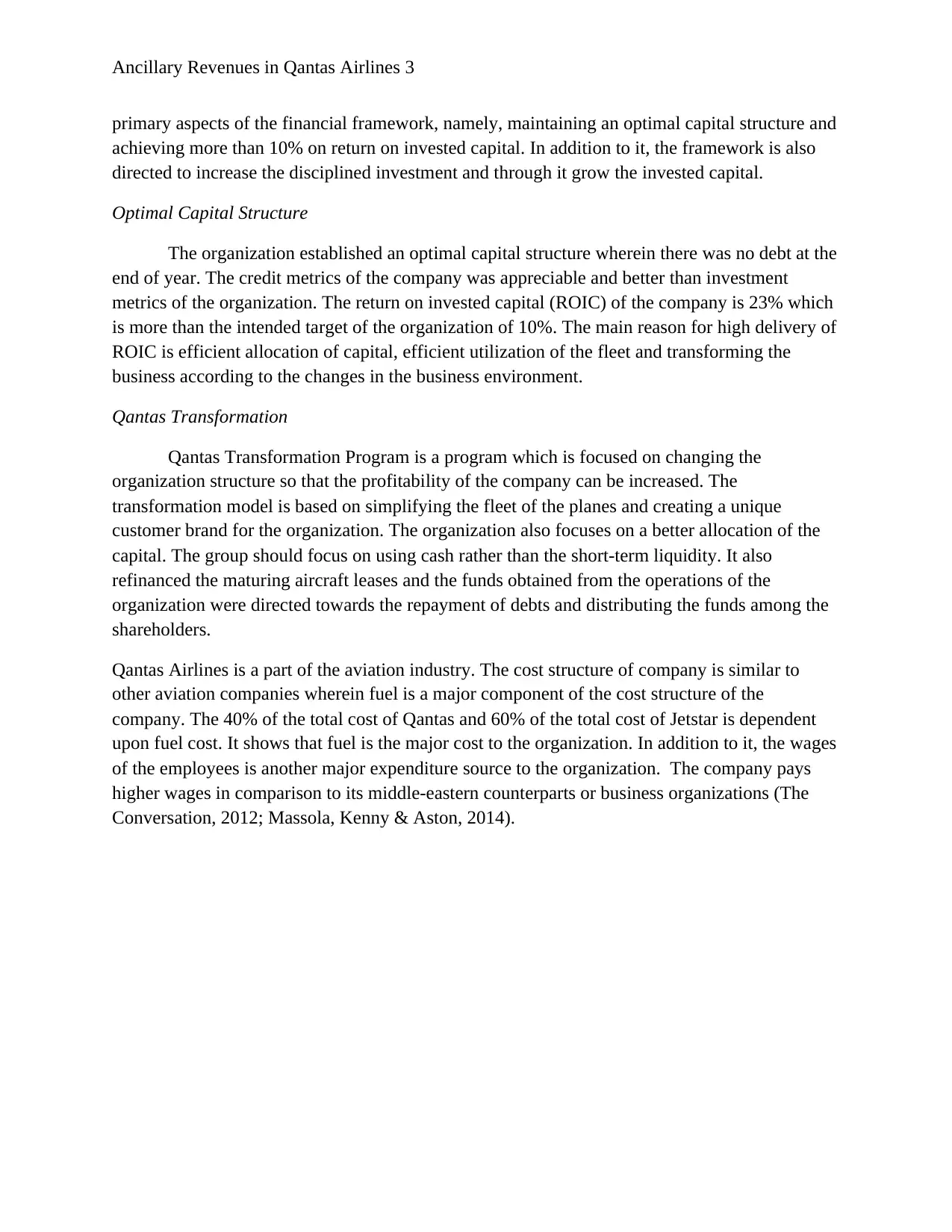
Ancillary Revenues in Qantas Airlines 3
primary aspects of the financial framework, namely, maintaining an optimal capital structure and
achieving more than 10% on return on invested capital. In addition to it, the framework is also
directed to increase the disciplined investment and through it grow the invested capital.
Optimal Capital Structure
The organization established an optimal capital structure wherein there was no debt at the
end of year. The credit metrics of the company was appreciable and better than investment
metrics of the organization. The return on invested capital (ROIC) of the company is 23% which
is more than the intended target of the organization of 10%. The main reason for high delivery of
ROIC is efficient allocation of capital, efficient utilization of the fleet and transforming the
business according to the changes in the business environment.
Qantas Transformation
Qantas Transformation Program is a program which is focused on changing the
organization structure so that the profitability of the company can be increased. The
transformation model is based on simplifying the fleet of the planes and creating a unique
customer brand for the organization. The organization also focuses on a better allocation of the
capital. The group should focus on using cash rather than the short-term liquidity. It also
refinanced the maturing aircraft leases and the funds obtained from the operations of the
organization were directed towards the repayment of debts and distributing the funds among the
shareholders.
Qantas Airlines is a part of the aviation industry. The cost structure of company is similar to
other aviation companies wherein fuel is a major component of the cost structure of the
company. The 40% of the total cost of Qantas and 60% of the total cost of Jetstar is dependent
upon fuel cost. It shows that fuel is the major cost to the organization. In addition to it, the wages
of the employees is another major expenditure source to the organization. The company pays
higher wages in comparison to its middle-eastern counterparts or business organizations (The
Conversation, 2012; Massola, Kenny & Aston, 2014).
primary aspects of the financial framework, namely, maintaining an optimal capital structure and
achieving more than 10% on return on invested capital. In addition to it, the framework is also
directed to increase the disciplined investment and through it grow the invested capital.
Optimal Capital Structure
The organization established an optimal capital structure wherein there was no debt at the
end of year. The credit metrics of the company was appreciable and better than investment
metrics of the organization. The return on invested capital (ROIC) of the company is 23% which
is more than the intended target of the organization of 10%. The main reason for high delivery of
ROIC is efficient allocation of capital, efficient utilization of the fleet and transforming the
business according to the changes in the business environment.
Qantas Transformation
Qantas Transformation Program is a program which is focused on changing the
organization structure so that the profitability of the company can be increased. The
transformation model is based on simplifying the fleet of the planes and creating a unique
customer brand for the organization. The organization also focuses on a better allocation of the
capital. The group should focus on using cash rather than the short-term liquidity. It also
refinanced the maturing aircraft leases and the funds obtained from the operations of the
organization were directed towards the repayment of debts and distributing the funds among the
shareholders.
Qantas Airlines is a part of the aviation industry. The cost structure of company is similar to
other aviation companies wherein fuel is a major component of the cost structure of the
company. The 40% of the total cost of Qantas and 60% of the total cost of Jetstar is dependent
upon fuel cost. It shows that fuel is the major cost to the organization. In addition to it, the wages
of the employees is another major expenditure source to the organization. The company pays
higher wages in comparison to its middle-eastern counterparts or business organizations (The
Conversation, 2012; Massola, Kenny & Aston, 2014).
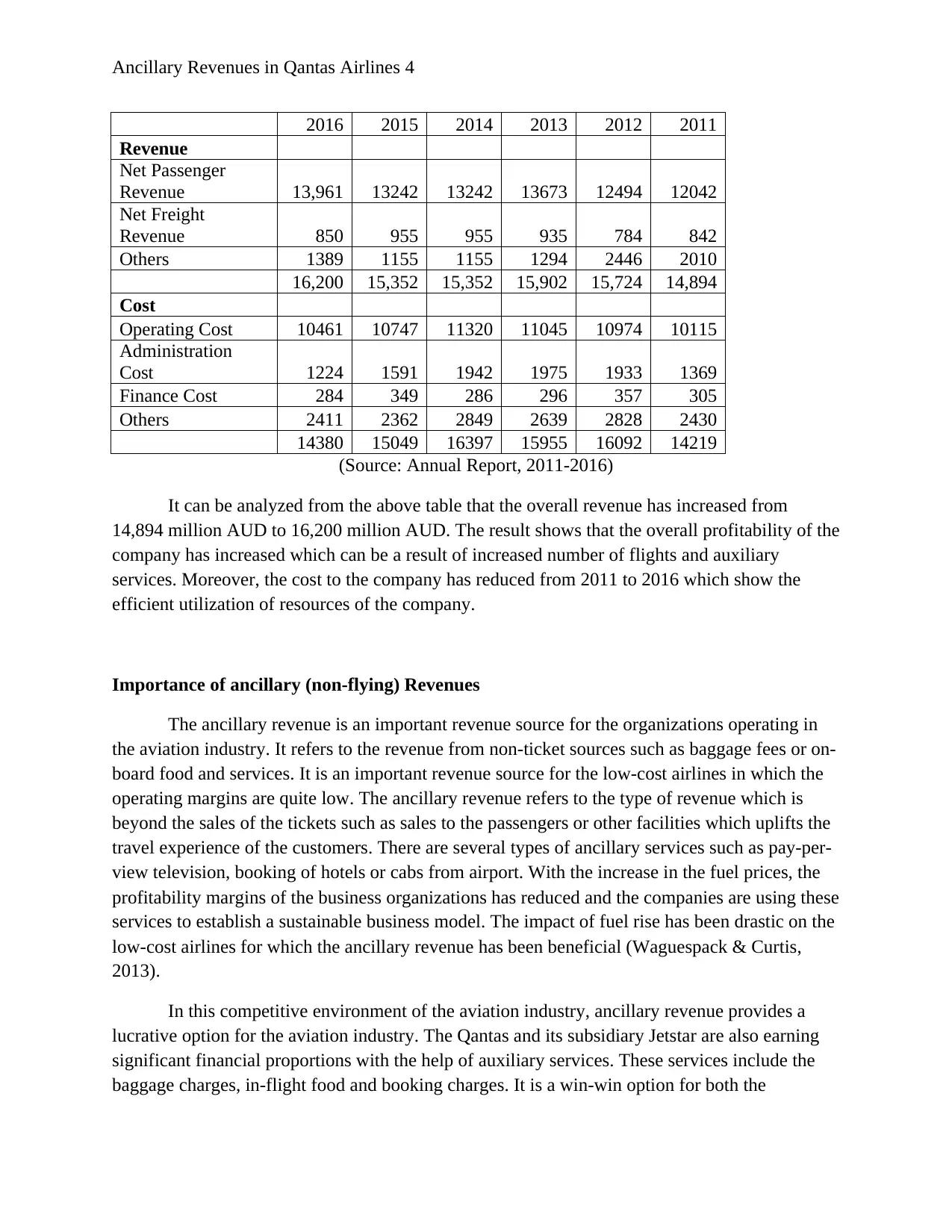
Ancillary Revenues in Qantas Airlines 4
2016 2015 2014 2013 2012 2011
Revenue
Net Passenger
Revenue 13,961 13242 13242 13673 12494 12042
Net Freight
Revenue 850 955 955 935 784 842
Others 1389 1155 1155 1294 2446 2010
16,200 15,352 15,352 15,902 15,724 14,894
Cost
Operating Cost 10461 10747 11320 11045 10974 10115
Administration
Cost 1224 1591 1942 1975 1933 1369
Finance Cost 284 349 286 296 357 305
Others 2411 2362 2849 2639 2828 2430
14380 15049 16397 15955 16092 14219
(Source: Annual Report, 2011-2016)
It can be analyzed from the above table that the overall revenue has increased from
14,894 million AUD to 16,200 million AUD. The result shows that the overall profitability of the
company has increased which can be a result of increased number of flights and auxiliary
services. Moreover, the cost to the company has reduced from 2011 to 2016 which show the
efficient utilization of resources of the company.
Importance of ancillary (non-flying) Revenues
The ancillary revenue is an important revenue source for the organizations operating in
the aviation industry. It refers to the revenue from non-ticket sources such as baggage fees or on-
board food and services. It is an important revenue source for the low-cost airlines in which the
operating margins are quite low. The ancillary revenue refers to the type of revenue which is
beyond the sales of the tickets such as sales to the passengers or other facilities which uplifts the
travel experience of the customers. There are several types of ancillary services such as pay-per-
view television, booking of hotels or cabs from airport. With the increase in the fuel prices, the
profitability margins of the business organizations has reduced and the companies are using these
services to establish a sustainable business model. The impact of fuel rise has been drastic on the
low-cost airlines for which the ancillary revenue has been beneficial (Waguespack & Curtis,
2013).
In this competitive environment of the aviation industry, ancillary revenue provides a
lucrative option for the aviation industry. The Qantas and its subsidiary Jetstar are also earning
significant financial proportions with the help of auxiliary services. These services include the
baggage charges, in-flight food and booking charges. It is a win-win option for both the
2016 2015 2014 2013 2012 2011
Revenue
Net Passenger
Revenue 13,961 13242 13242 13673 12494 12042
Net Freight
Revenue 850 955 955 935 784 842
Others 1389 1155 1155 1294 2446 2010
16,200 15,352 15,352 15,902 15,724 14,894
Cost
Operating Cost 10461 10747 11320 11045 10974 10115
Administration
Cost 1224 1591 1942 1975 1933 1369
Finance Cost 284 349 286 296 357 305
Others 2411 2362 2849 2639 2828 2430
14380 15049 16397 15955 16092 14219
(Source: Annual Report, 2011-2016)
It can be analyzed from the above table that the overall revenue has increased from
14,894 million AUD to 16,200 million AUD. The result shows that the overall profitability of the
company has increased which can be a result of increased number of flights and auxiliary
services. Moreover, the cost to the company has reduced from 2011 to 2016 which show the
efficient utilization of resources of the company.
Importance of ancillary (non-flying) Revenues
The ancillary revenue is an important revenue source for the organizations operating in
the aviation industry. It refers to the revenue from non-ticket sources such as baggage fees or on-
board food and services. It is an important revenue source for the low-cost airlines in which the
operating margins are quite low. The ancillary revenue refers to the type of revenue which is
beyond the sales of the tickets such as sales to the passengers or other facilities which uplifts the
travel experience of the customers. There are several types of ancillary services such as pay-per-
view television, booking of hotels or cabs from airport. With the increase in the fuel prices, the
profitability margins of the business organizations has reduced and the companies are using these
services to establish a sustainable business model. The impact of fuel rise has been drastic on the
low-cost airlines for which the ancillary revenue has been beneficial (Waguespack & Curtis,
2013).
In this competitive environment of the aviation industry, ancillary revenue provides a
lucrative option for the aviation industry. The Qantas and its subsidiary Jetstar are also earning
significant financial proportions with the help of auxiliary services. These services include the
baggage charges, in-flight food and booking charges. It is a win-win option for both the
Secure Best Marks with AI Grader
Need help grading? Try our AI Grader for instant feedback on your assignments.
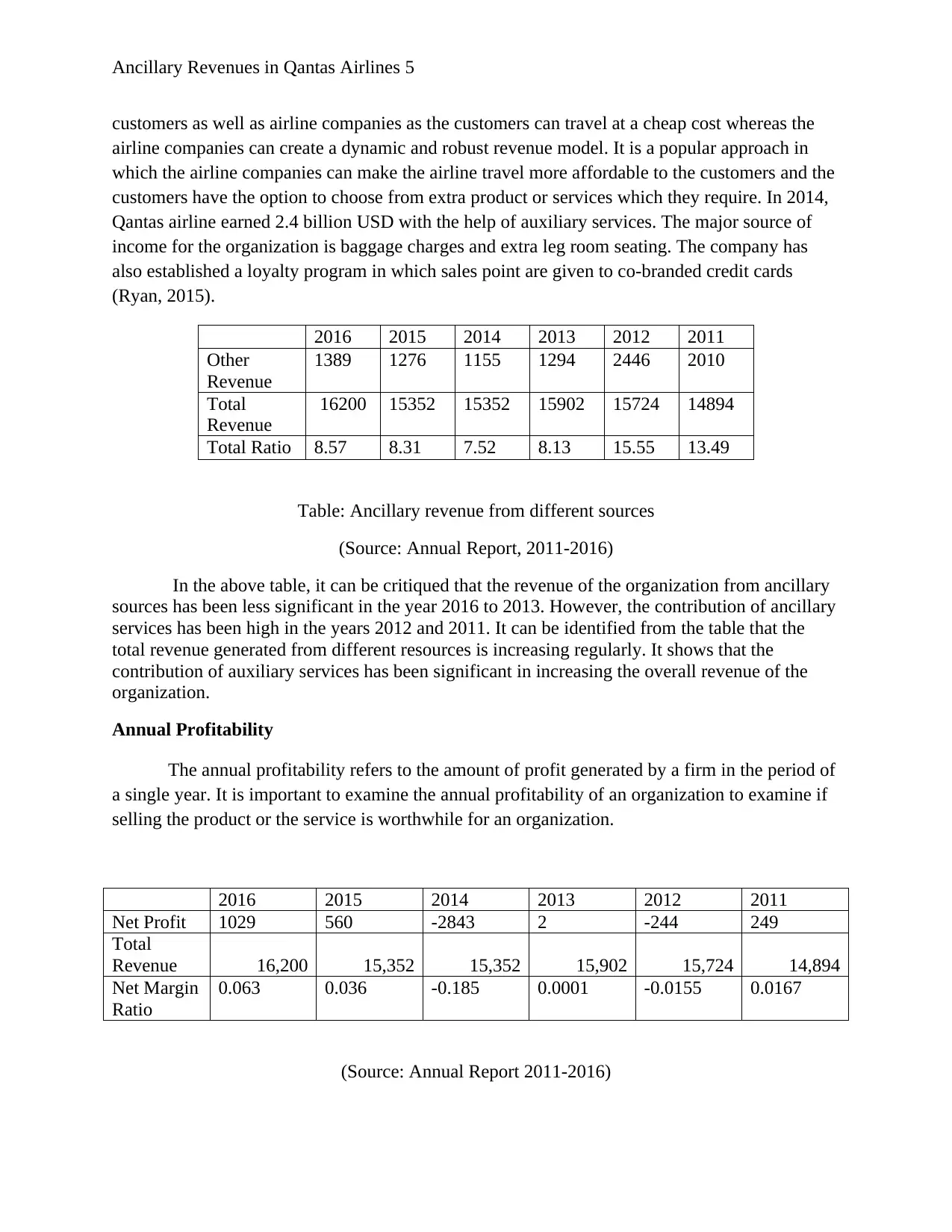
Ancillary Revenues in Qantas Airlines 5
customers as well as airline companies as the customers can travel at a cheap cost whereas the
airline companies can create a dynamic and robust revenue model. It is a popular approach in
which the airline companies can make the airline travel more affordable to the customers and the
customers have the option to choose from extra product or services which they require. In 2014,
Qantas airline earned 2.4 billion USD with the help of auxiliary services. The major source of
income for the organization is baggage charges and extra leg room seating. The company has
also established a loyalty program in which sales point are given to co-branded credit cards
(Ryan, 2015).
2016 2015 2014 2013 2012 2011
Other
Revenue
1389 1276 1155 1294 2446 2010
Total
Revenue
16200 15352 15352 15902 15724 14894
Total Ratio 8.57 8.31 7.52 8.13 15.55 13.49
Table: Ancillary revenue from different sources
(Source: Annual Report, 2011-2016)
In the above table, it can be critiqued that the revenue of the organization from ancillary
sources has been less significant in the year 2016 to 2013. However, the contribution of ancillary
services has been high in the years 2012 and 2011. It can be identified from the table that the
total revenue generated from different resources is increasing regularly. It shows that the
contribution of auxiliary services has been significant in increasing the overall revenue of the
organization.
Annual Profitability
The annual profitability refers to the amount of profit generated by a firm in the period of
a single year. It is important to examine the annual profitability of an organization to examine if
selling the product or the service is worthwhile for an organization.
2016 2015 2014 2013 2012 2011
Net Profit 1029 560 -2843 2 -244 249
Total
Revenue 16,200 15,352 15,352 15,902 15,724 14,894
Net Margin
Ratio
0.063 0.036 -0.185 0.0001 -0.0155 0.0167
(Source: Annual Report 2011-2016)
customers as well as airline companies as the customers can travel at a cheap cost whereas the
airline companies can create a dynamic and robust revenue model. It is a popular approach in
which the airline companies can make the airline travel more affordable to the customers and the
customers have the option to choose from extra product or services which they require. In 2014,
Qantas airline earned 2.4 billion USD with the help of auxiliary services. The major source of
income for the organization is baggage charges and extra leg room seating. The company has
also established a loyalty program in which sales point are given to co-branded credit cards
(Ryan, 2015).
2016 2015 2014 2013 2012 2011
Other
Revenue
1389 1276 1155 1294 2446 2010
Total
Revenue
16200 15352 15352 15902 15724 14894
Total Ratio 8.57 8.31 7.52 8.13 15.55 13.49
Table: Ancillary revenue from different sources
(Source: Annual Report, 2011-2016)
In the above table, it can be critiqued that the revenue of the organization from ancillary
sources has been less significant in the year 2016 to 2013. However, the contribution of ancillary
services has been high in the years 2012 and 2011. It can be identified from the table that the
total revenue generated from different resources is increasing regularly. It shows that the
contribution of auxiliary services has been significant in increasing the overall revenue of the
organization.
Annual Profitability
The annual profitability refers to the amount of profit generated by a firm in the period of
a single year. It is important to examine the annual profitability of an organization to examine if
selling the product or the service is worthwhile for an organization.
2016 2015 2014 2013 2012 2011
Net Profit 1029 560 -2843 2 -244 249
Total
Revenue 16,200 15,352 15,352 15,902 15,724 14,894
Net Margin
Ratio
0.063 0.036 -0.185 0.0001 -0.0155 0.0167
(Source: Annual Report 2011-2016)

Ancillary Revenues in Qantas Airlines 6
It can be critiqued that from the above table that the net margin ratio has increased from
the year 2011 to 2016. The shows that the organization has positive profitability trend for the
upcoming years.
Key performance Drivers of Qantas as a Major full Service Network Carrier
Qantas is one of the major full service carriers in the airline industry. The organization
provides flying services along with several auxiliary services. There are several cost and revenue
factors which are significant in the growth of the organization. The major factors in the growth
of the organization are demand, price, service quality and the economic conditions. The demand
of the service impacts positively on the profitability of the business. If the demand of the service
increases, then the organization’s sales increase. In addition to it, the price, service quality and
the economic conditions of the market also impacts on the revenue of the organization. In the
recent years, the organization has increased the demand of the services by enhancing the quality
of the service provided to the customers. The service quality has been enhanced by introducing
several auxiliary services to the customers. The organization also tries to increase the service
quality by keeping the price of the tickets constant. The economy of Australia is developed and
progressive and the customers have spare income to spend on their leisure travel and luxury
(Cronrath, 2017).
There are also several other factors which may impact on the overall cost to the
organization. The management of the company and the resource utilization are significant to the
overall cost to the organization. If the organization is managing itself in a proper manner then it
will increase the efficiency and productivity of the organization. The company has implemented
several programs for effective resource utilization. It includes the use of human resource
programs and financial resource programs for the organization.
Conclusion
It can be concluded that the auxiliary services have been critical in increasing the overall
profitability of the organization. In the report, the revenue sources and cost structure of the
organization have been evaluated. It has been examined that the company will realize positive
trends in terms of revenue in near future.
It can be critiqued that from the above table that the net margin ratio has increased from
the year 2011 to 2016. The shows that the organization has positive profitability trend for the
upcoming years.
Key performance Drivers of Qantas as a Major full Service Network Carrier
Qantas is one of the major full service carriers in the airline industry. The organization
provides flying services along with several auxiliary services. There are several cost and revenue
factors which are significant in the growth of the organization. The major factors in the growth
of the organization are demand, price, service quality and the economic conditions. The demand
of the service impacts positively on the profitability of the business. If the demand of the service
increases, then the organization’s sales increase. In addition to it, the price, service quality and
the economic conditions of the market also impacts on the revenue of the organization. In the
recent years, the organization has increased the demand of the services by enhancing the quality
of the service provided to the customers. The service quality has been enhanced by introducing
several auxiliary services to the customers. The organization also tries to increase the service
quality by keeping the price of the tickets constant. The economy of Australia is developed and
progressive and the customers have spare income to spend on their leisure travel and luxury
(Cronrath, 2017).
There are also several other factors which may impact on the overall cost to the
organization. The management of the company and the resource utilization are significant to the
overall cost to the organization. If the organization is managing itself in a proper manner then it
will increase the efficiency and productivity of the organization. The company has implemented
several programs for effective resource utilization. It includes the use of human resource
programs and financial resource programs for the organization.
Conclusion
It can be concluded that the auxiliary services have been critical in increasing the overall
profitability of the organization. In the report, the revenue sources and cost structure of the
organization have been evaluated. It has been examined that the company will realize positive
trends in terms of revenue in near future.
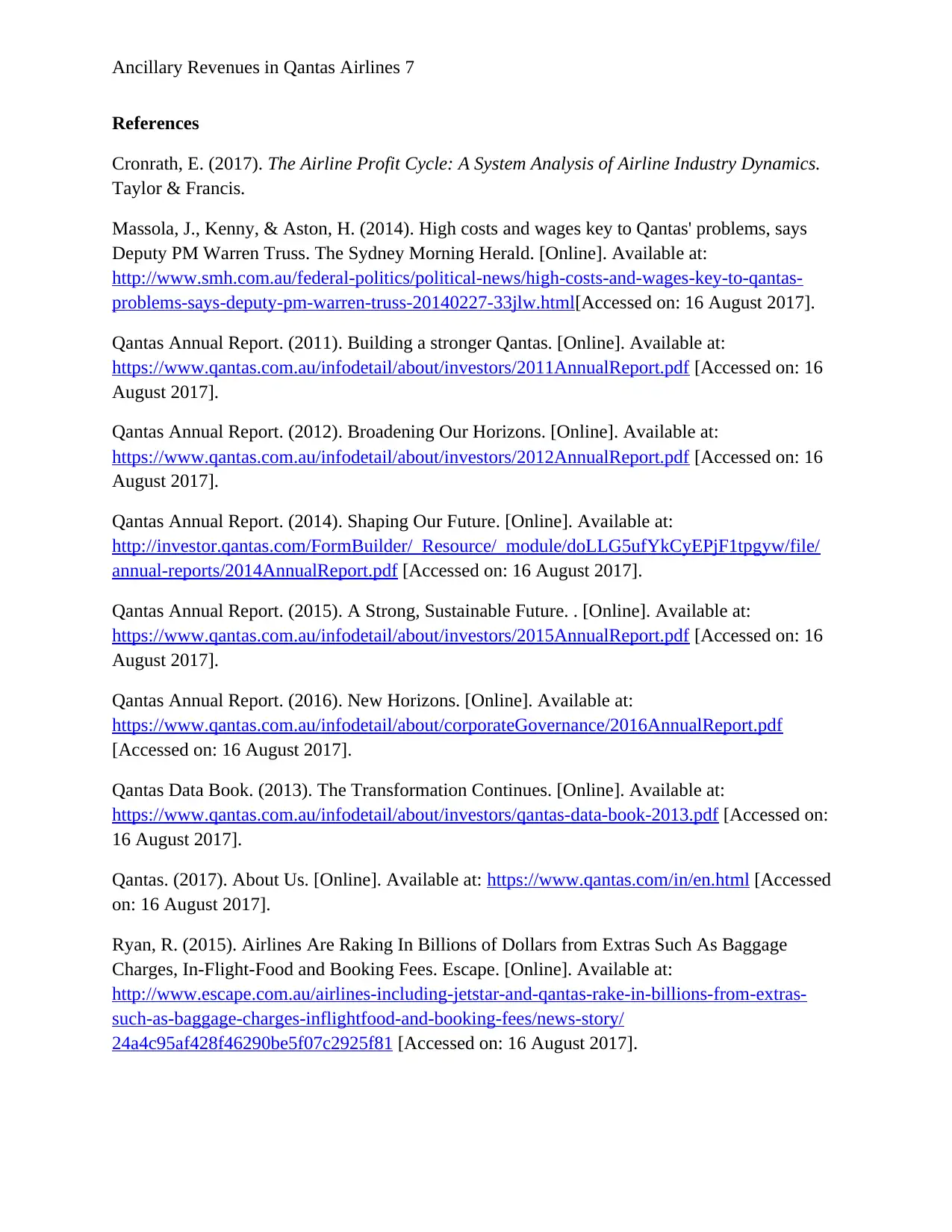
Ancillary Revenues in Qantas Airlines 7
References
Cronrath, E. (2017). The Airline Profit Cycle: A System Analysis of Airline Industry Dynamics.
Taylor & Francis.
Massola, J., Kenny, & Aston, H. (2014). High costs and wages key to Qantas' problems, says
Deputy PM Warren Truss. The Sydney Morning Herald. [Online]. Available at:
http://www.smh.com.au/federal-politics/political-news/high-costs-and-wages-key-to-qantas-
problems-says-deputy-pm-warren-truss-20140227-33jlw.html[Accessed on: 16 August 2017].
Qantas Annual Report. (2011). Building a stronger Qantas. [Online]. Available at:
https://www.qantas.com.au/infodetail/about/investors/2011AnnualReport.pdf [Accessed on: 16
August 2017].
Qantas Annual Report. (2012). Broadening Our Horizons. [Online]. Available at:
https://www.qantas.com.au/infodetail/about/investors/2012AnnualReport.pdf [Accessed on: 16
August 2017].
Qantas Annual Report. (2014). Shaping Our Future. [Online]. Available at:
http://investor.qantas.com/FormBuilder/_Resource/_module/doLLG5ufYkCyEPjF1tpgyw/file/
annual-reports/2014AnnualReport.pdf [Accessed on: 16 August 2017].
Qantas Annual Report. (2015). A Strong, Sustainable Future. . [Online]. Available at:
https://www.qantas.com.au/infodetail/about/investors/2015AnnualReport.pdf [Accessed on: 16
August 2017].
Qantas Annual Report. (2016). New Horizons. [Online]. Available at:
https://www.qantas.com.au/infodetail/about/corporateGovernance/2016AnnualReport.pdf
[Accessed on: 16 August 2017].
Qantas Data Book. (2013). The Transformation Continues. [Online]. Available at:
https://www.qantas.com.au/infodetail/about/investors/qantas-data-book-2013.pdf [Accessed on:
16 August 2017].
Qantas. (2017). About Us. [Online]. Available at: https://www.qantas.com/in/en.html [Accessed
on: 16 August 2017].
Ryan, R. (2015). Airlines Are Raking In Billions of Dollars from Extras Such As Baggage
Charges, In-Flight-Food and Booking Fees. Escape. [Online]. Available at:
http://www.escape.com.au/airlines-including-jetstar-and-qantas-rake-in-billions-from-extras-
such-as-baggage-charges-inflightfood-and-booking-fees/news-story/
24a4c95af428f46290be5f07c2925f81 [Accessed on: 16 August 2017].
References
Cronrath, E. (2017). The Airline Profit Cycle: A System Analysis of Airline Industry Dynamics.
Taylor & Francis.
Massola, J., Kenny, & Aston, H. (2014). High costs and wages key to Qantas' problems, says
Deputy PM Warren Truss. The Sydney Morning Herald. [Online]. Available at:
http://www.smh.com.au/federal-politics/political-news/high-costs-and-wages-key-to-qantas-
problems-says-deputy-pm-warren-truss-20140227-33jlw.html[Accessed on: 16 August 2017].
Qantas Annual Report. (2011). Building a stronger Qantas. [Online]. Available at:
https://www.qantas.com.au/infodetail/about/investors/2011AnnualReport.pdf [Accessed on: 16
August 2017].
Qantas Annual Report. (2012). Broadening Our Horizons. [Online]. Available at:
https://www.qantas.com.au/infodetail/about/investors/2012AnnualReport.pdf [Accessed on: 16
August 2017].
Qantas Annual Report. (2014). Shaping Our Future. [Online]. Available at:
http://investor.qantas.com/FormBuilder/_Resource/_module/doLLG5ufYkCyEPjF1tpgyw/file/
annual-reports/2014AnnualReport.pdf [Accessed on: 16 August 2017].
Qantas Annual Report. (2015). A Strong, Sustainable Future. . [Online]. Available at:
https://www.qantas.com.au/infodetail/about/investors/2015AnnualReport.pdf [Accessed on: 16
August 2017].
Qantas Annual Report. (2016). New Horizons. [Online]. Available at:
https://www.qantas.com.au/infodetail/about/corporateGovernance/2016AnnualReport.pdf
[Accessed on: 16 August 2017].
Qantas Data Book. (2013). The Transformation Continues. [Online]. Available at:
https://www.qantas.com.au/infodetail/about/investors/qantas-data-book-2013.pdf [Accessed on:
16 August 2017].
Qantas. (2017). About Us. [Online]. Available at: https://www.qantas.com/in/en.html [Accessed
on: 16 August 2017].
Ryan, R. (2015). Airlines Are Raking In Billions of Dollars from Extras Such As Baggage
Charges, In-Flight-Food and Booking Fees. Escape. [Online]. Available at:
http://www.escape.com.au/airlines-including-jetstar-and-qantas-rake-in-billions-from-extras-
such-as-baggage-charges-inflightfood-and-booking-fees/news-story/
24a4c95af428f46290be5f07c2925f81 [Accessed on: 16 August 2017].
Paraphrase This Document
Need a fresh take? Get an instant paraphrase of this document with our AI Paraphraser

Ancillary Revenues in Qantas Airlines 8
The Conversation. (2012). The upside to Qantas and Jetstar’s price hikes. [Online]. Available at:
http://theconversation.com/the-upside-to-qantas-and-jetstars-price-hikes-5175 [Accessed on: 16
August 2017].
Waguespack, B. P., & Curtis, T. (2013). Ancillary Revenue and Price Fairness: An Exploratory
Study Pre & Post Flight. , ().[Online]. Available at: http://commons.erau.edu/publication/70
[Accessed on: 16 August 2017].
The Conversation. (2012). The upside to Qantas and Jetstar’s price hikes. [Online]. Available at:
http://theconversation.com/the-upside-to-qantas-and-jetstars-price-hikes-5175 [Accessed on: 16
August 2017].
Waguespack, B. P., & Curtis, T. (2013). Ancillary Revenue and Price Fairness: An Exploratory
Study Pre & Post Flight. , ().[Online]. Available at: http://commons.erau.edu/publication/70
[Accessed on: 16 August 2017].
1 out of 8
Related Documents
Your All-in-One AI-Powered Toolkit for Academic Success.
+13062052269
info@desklib.com
Available 24*7 on WhatsApp / Email
![[object Object]](/_next/static/media/star-bottom.7253800d.svg)
Unlock your academic potential
© 2024 | Zucol Services PVT LTD | All rights reserved.





